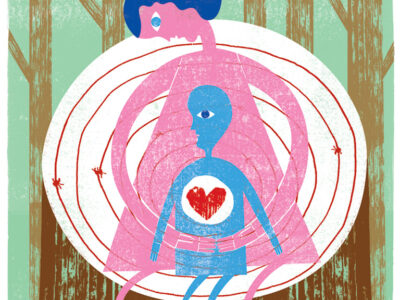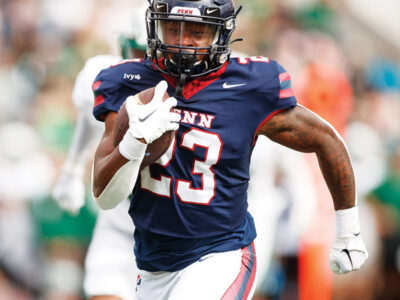When she couldn’t distract herself with histories of the Babylonian empire or the Peloponnesian War, Kathy Brearley turned to Agatha Christie. New mystery stories, she hoped, would help her cope with the horrible mystery she’d lived with every day since her youngest son, Owen Thomas W’11, a star player on the Penn football team, hanged himself in his off-campus apartment on April 26. But in reality, there was no escaping the anguish and confusion that, by her estimation, controlled 99 percent of her thoughts.
“All I had, all summer, was an unexplained death,” says Brearley. “I just couldn’t believe not being able to do well on two exams could ever make a person like Owen go out and kill himself with no advance warning.”
The grief certainly won’t stop, but after a summer of soul-searching, Brearley at least has some possible answers. In early September, doctors at Boston University determined through a brain autopsy that Thomas suffered from stage two of chronic traumatic encephalopathy (CTE), a degenerative brain disease linked to depression and possibly caused by playing football from a young age.
While this discovery, first reported by Alan Schwarz C’90 of The New York Times, is not enough on its own to explain why a popular student-athlete entering the prime of his life would commit suicide (college students in general have higher rates of suicide than the population at large), it could trigger an overhaul of football safety procedures at the amateur level. The cause of CTE is repetitive trauma to the brain, but what makes this particular case so unique is that Thomas never had a concussion during his playing days—at least not one that was documented. According to Schwarz’s report, previous cases of CTE were found in NFL players who had a history of concussions. Thomas is the first amateur player ever found with the disease.
“It makes sense of a senseless situation, that’s true,” says Brearley, a pastor in Allentown, Pennslvania. “But it also raises a sense of responsibility. Now that you have this knowledge, what are you going to do with it? What does it mean for the health and safety of younger athletes?”
Following the report, the University issued a statement that read in part: “We are aware and deeply concerned about the medical issues now being raised about football head injuries and will continue to work with the Ivy League and the medical community in addressing these issues.” Lori Doyle, Penn’s vice president of communications, independently confirmed that the Ivy League Council of Presidents has formally discussed the issue.
Penn head football coach Al Bagnoli and his training staff have always been cautious in dealing with head injuries. In 2002 Bagnoli opted to sit out cornerback Rudy Brown W’04 for an entire season when the cornerback suffered his fourth concussion in four years (from an off-field accident, as it so happened), telling The Daily Pennsylvanian, “You don’t want to screw around with a kid’s head.” But the longtime coach doesn’t know what to make of what are being called “sub-concussive” brain injuries caused by a series of hits and tackles over a long period of time. Football, after all, would not exist in its current form without hits and tackles.
“I’m not sure how conclusive one case is,” Bagnoli says. “I don’t know enough about it and I think we have to be careful what we draw in terms of conclusions until we get a comprehensive look at everything. But obviously it’s an issue for everybody, from the NFL on down.”
The NCAA recently implemented two rules designed to address the risks of head injuries in football. One bans the use of “wedge” formations on kickoff returns (which typically prompt opposing players to hurl their bodies into the wedge to break it up). The other closes a loophole in the requirement that injured players be removed from the field for at least one play, giving doctors a chance to evaluate them; teams could previously get around the rule by using a time-out to keep an injured player in the game. The NCAA rules prohibit helmet-first tackles.
Brearley and her husband, Rev. Tom Thomas, still love football but hope further precautions—perhaps more screening and less contact in practice—will find their way into the sport across all levels, starting with the Ancient Eight. “I think this does provide an opportunity for Ivy League schools to stand up and take a leadership role in this, because Ivy League people are leaders,” Brearley says.
Doug Smith, director of the Penn Center for Brain Injury and Repair, says there’s no quick-fix band-aid for football-related CTE. A very large problem, he says, is that diagnosing brain diseases involves a fair bit of guesswork and conjecture. “My concern is that a player can appear completely normal after a big hit but the brain itself is getting scrambled,” says Smith, who hasn’t been asked by Penn or the Ivy League to specifically help with preventing football injuries but would be open to it. “We don’t know how long that period of vulnerability is.”
Down the road, perhaps, there could be ways to screen athletes using MRIs or blood tests, but such solutions might be cost-prohibitive for amateur-level teams. And neither of those methods, Smith says, is “ready for primetime.” Furthermore, even if more preventive measures were put in place it would still be hard to figure out the true impact of “sub-concussive” blows. “That’s one of those new terms to alert everyone to the possibility that a blow to the head that doesn’t cause a loss of consciousness can have a cumulative effect,” Smith says. “But there is no evidence that that’s a problem. We all believe there is a threshold. You obviously hit your head a lot during your life and it doesn’t cause brain injury. We know there is a good range and there is a bad range; it’s that gray area that is unknown.”
At the very least, Brearley hopes her own chilling tale can educate other families around the country that brain injuries can happen to anyone. She learned the hardest way possible. When concussion expert Chris Nowinski—a former professional wrestler and Harvard alumnus who oversees the Sports Legacy Institute, whose primary focus is studying CTE—first called her to request Owen’s brain tissue, she agreed but told him it probably wouldn’t be of any use to him. She reiterated the same thing to Robert Stern, the Boston University doctor in charge of the study.
When the results came in, the Thomas family was astounded—a feeling that soon morphed into hope. Owen Thomas was always a leader on the football field. Perhaps he will, in a different sense, be a leader still, in the months, years, and even decades after his death.
“Since Owen never had any documented concussions, you have to wonder if sub-concussions have a cumulative effect,” Brearley says. “Part of his legacy is to open that debate.”
—Dave Zeitlin C’03




